|
According to "Who's Who in Army Aviation" for 1922 and 1928, Y.H. "Buck" Taylor was born July 28, 1898 at Bartlett, TX. After high school he attended the Peacock Military College. Below, an early photograph of Taylor, probably during the time he was at Peacock. Photo courtesy of site visitor R. Terrell.
Y.H. Taylor, Early Portrait, Date Unknown (Source: Terrell)
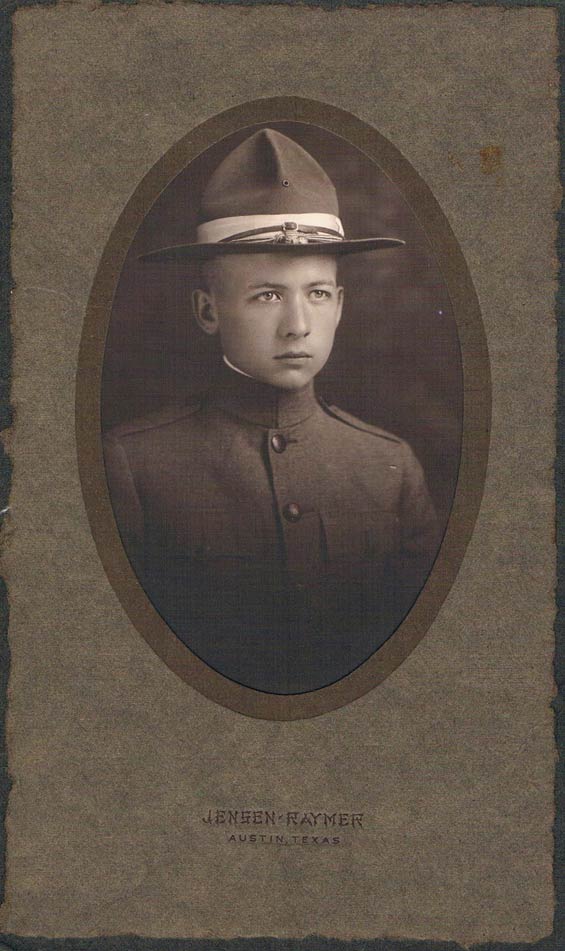 |
He was in the contracting business before WWI, then trained at Kelly Field, TX, becoming an aviator in 1919. He then took up commercial flying and advertising for a newspaper for the next four years and was commissioned 2nd Lt. in the Texas National Guard Air Service on January 19, 1922. He was then assigned to locate bootleg stills from the air in east Texas.
Locating stills was a risky activity. Below, from site visitor C.L, is an image of Taylor with an aircraft flown on behalf of the Mexia (TX) Telegram. This postcard-type photograph was professionally labeled and probably distributed in support of the newspaper. Taylor was about 24 years old in this photograph.
Yantis Taylor, Pilot, District Air Service Officer, Ca. February 3, 1922 (Source: C.L.)
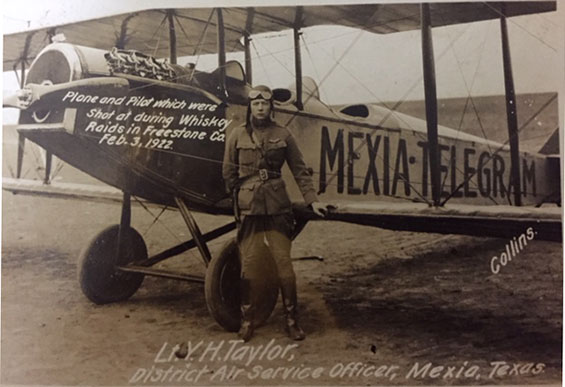 |
That Freestone County, TX was dangerous is supported by this statement from the Texas U.S. Genweb Archives, "'Whiskey Days' Told that when the Rangers and State Militia came to Mexia on the trains that hoodlums, robbers, prostitutes and other law breakers rode the same trains out of town or one shortly after. Rangers in those days were very powerful, their word was virtually law and a single action 44 or 45 enforced it. Then they shot first and asked questions alter Martial Law was lifted March 1, l922 following the Grand Jury reports in Limestone and Freestone Co. One law enforcement officer testified and apologized for their actions and lack of experience in these type situations, He also was the person from whom the land for the Chicken Farm was secured. Shortly after Freestone Co. Sheriff Horace Mayo made raids on some stills and published a long article in the local papers in defense of his activities. Martial Law accomplished little as the violations continued for many years."
And, indeed, violations did continue for many years. The Mexia Weekly Herald (Mexia, Texas) for October 3, 1930 headlined on page 3:
"GAS BURNERS ON RUM STILL." It reported, " Federal Men Raiding Freestone Find Six Stills WACO, Sept 27 - Moonshiners in Freestone county are using a new wrinkle in their plants - gas burners and compression tanks instead of wood fuel. The first still which prohibition officers have found in that county so equipped was destroyed this week, they reported Friday when they returned to Waco, after three days work and destruction of six stills.
"The explaination of the innovation is easy, one of the officers said: 'Burners make no smoke. No smoke, no sign for the agents.'
"Pack Mule. Besides destroying the six stills and finding the gas burner outfit the agents arrested one man whom they said was escorting away from a still a mule laden with 24 gallons of whiskey - in half gallon jars placed in cotton sacks and carry three gallons himself.
"They destroyed two stills, of 100 and 150 gallon size on Tuesday; three on Wednesday of 100, 400 and 500 gallon size; and one of 200 gallon size on Thursday. They also found three location where copper "pots" had been taken home when cooking was finished. All other equipment was destroyed.
"Much Destroyed. Conservative estimate was that they had poured out 5000 gallons of mash, 100 gallons of whiskey, destroyed six pots, three pumps and 20 500-gallon vats during the week.
"The man alleged to have been escourting [sic] the whiskey laden mule - Ernest Minchew - is under $750 bond to answer charge of violation of the national prohibition laws. A hearing was held before United States Commissioner A.P. McCormick." |
After his whiskey still adventure, Taylor then took an advanced flying course at Kelly Field, graduated in late 1925 with a Pursuit rating, and was commissioned in the Regular Army September 8, 1926. He then was assigned as a flight instructor at Kelly Field.
Bartlett (TX) Tribune & News, October 7, 1927 (Source: Web)
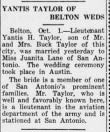 |
Taylor landed three times at Tucson. His first visit was Monday, October 31, 1927 in the Consolidated PT-1, 26-319. He carried as passenger one Lt. Adams. Based at Kelly Field, San Antonio, TX, they were westbound from San Antonio to Riverside, CA, March Field. At this landing he was a newlywed, as reported in the Bartlett (TX) Tribune and News of October 7, 1927, left.
Taylor's claims to fame during the Golden Age were a couple of long-distance flights. Two years after his first visit at Tucson, The New York Times of June 23, 1929 reported on his successful circumnavigation of the state of Texas. The article stated that Taylor, "... flew the 2,090-mile perimeter of the State of Texas recently in 16 hours and 10 minutes flying time with a standard Curtiss D-12 motored Hawk. He spent 35 minutes on the ground during the trip and returned to Kelley [sic] Field, his starting point, on the evening of the same day as the hop-off. He said he had made no preparation for the flight, which was intended to demonstrate the reliability of the airplane under ordinary conditions."
A photograph of Taylor (L) posed by a Curtiss D-12-powered Hawk is below, courtesy of site visitor Sasha Ressetar. We do not know the date of this photo, but the location was Kelly Field. The other gentleman is Ressetar's godfather, Major Frank Korolishin. We do not know if this Curtiss is the one he used to circumnavigate Texas.
Y.H. Taylor (L) & Frank Korolishin, Kelly Field, TX, Date Unknown (Source: Ressetar)
 |
The airplane, 27-214, was written off August 12, 1931 at Kelly Field, TX.
Taylor's second landing at Tucson was on Sunday, March 23, 1930, just a few months before his second long-distance flight. Based again at San Antonio, he visited solo in the Douglas O-2K, 29-189. He was eastbound from San Diego, CA, Rockwell Field to El Paso, TX, Ft. Bliss. No reason was given in the Register for either of these visits.
His second distance flight was chronicled in several articles contained in his NASM biographical file (cited, left sidebar). On July 2-3, 1930, he flew the 2,100 miles from Laredo, TX to Kelly Field to Muskogee, OK to St. Louis, MO to Dayton, OH to Middletown, PA and to Portland, ME in 15 hours flying time. Departing at 1:10AM CST from Laredo, he landed at Portland at 7:27PM EST. His average speed was 140MPH at an average altitude of 4,000 feet in a Curtiss Hawk. He remained on the ground at his five stops for 1 hour and 15 minutes total. The Army backed and supported his flight as a test of the efficacy of sudden mobilization of the Army Air Corps. Below, Taylor is pictured with the airport manager right after landing at Portland. This photograph is shared with us by site contributor Tim Kalina. The dirty jumpsuit and sweaty armpits are testimony to the arduousness of the flight. He appeared, however, to wear a necktie and slacks, probably an Army uniform, under the jumpsuit. Compare Taylor's gym shoes with the ones on the gentleman third from right in this photograph.
Y.H. Taylor (L), Portland, ME, July 3, 1930 (Source: Kalina)
 |
The Newark (NJ) Ledger of Thursday, July 3, 1929 observed, "Taylor appeared little the worse for the long flight except for bloodshot eyes." Taylor said he would stay in Portland, "... a few days and then return to Texas, making the return flight in easy stages."
Taylor's third and final landing at Tucson was on Tuesday, July 3, 1934 (exactly four years after his landing at Portland, ME). He was solo in Boeing P-26, 33-138. He listed his homebase as Selfridge Field, Detroit, MI. He was eastbound from San Diego, CA Rockwell Field to El Paso, TX. I have no information about his duties during the 1930s. If you can help, please let me KNOW.
Site visitor Terrell shares some refreshing anecdotes with us regarding Taylor's personal life. He was a friend of the family, and Ms. Terrell states, "Yantis dated my great- aunt Daisy ..., and both families expected that they would marry. At some time early in his career, he took Daisy for a "joy ride" in his airplane and they buzzed the Bell County Courthouse, where Daisy's father ... worked. It caused quite a stir and everyone in Belton thought it was quite scandalous at the time. Yantis went on to San Antonio and met his future wife. My Aunt Daisy married another man shortly thereafter but that union didn't last. ... In the early 1930's, my [family] moved to Austin, Texas. [They] remained on good terms with Yantis and his family throughout the years.
"During WWII, due to a shortage of military housing in the Austin area, Austinites were asked to rent lodging to young officers at Bergstrom Field. My great-grandfather had a large 2 story home in Austin and rented one room to two young lieutenants. I do not remember both names, but one was Richard ..., the other was named Charles. They were best buddies and they went by the nicknames of Dick and Chuck. One evening, Yantis Taylor was in town, and dropped by the house to visit his old Belton friends.
" At the time, the family and the young lieutenants were playing cards. When General Taylor walked into the room, they both bolted to their feet to salute, knocking over the card table. They were pretty flustered because his visit was unexpected and I don't think they knew what to say or do. According to my grandmother and mother, General Taylor tried to put the boys at ease and asked them their names. One of the lieutenants said, "you can just call us Duck and Chick," mixing up their names from Dick and Chuck. Everyone got a big laugh out of it and that kind of broke the tension and put them at ease. After that, our family always referred to the young men as Duck and Chick."
Yantis H. Taylor, Ca. 1940s (Source: SJAFBLDC)
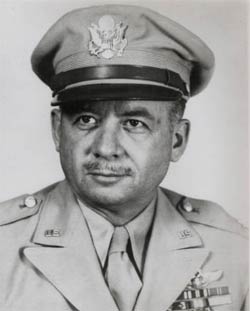 |
At right is an image of Taylor, ca. 1940s, from the Seymour Johnson Air Force Base Library Digital Collections (SJAFBLDC; public domain image). During WWII, then Colonel Taylor commanded the 306th Fighter Wing flying P-47s and P-51s based at Fano, Italy from September, 1944 to August, 1945. The Wing operated in the Mediterranean and European theaters until the end of the war when it was moved to the U.S. and dissolved in November, 1945.
The Bartlett (TX) Tribune, June 22, 1945 (Source: Web)
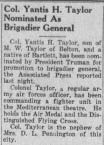 |
Just before WWII ended, he was promoted to Brigadier General. His hometown newspaper, the Bartlett (TX) Tribune of June 22, 1945 reported his promotion recommended by President Truman, left. He retired from the military in 1949. He died at age 58 on October 22, 1956.
His obituary from The New York Times of October 24, 1956 briefly summarizes his career, below. His daughter, brother, father and his bride of 1927 survived him.
Y.H. Taylor Obituary, The New York Times, October 24, 1956 (Source: NYT)
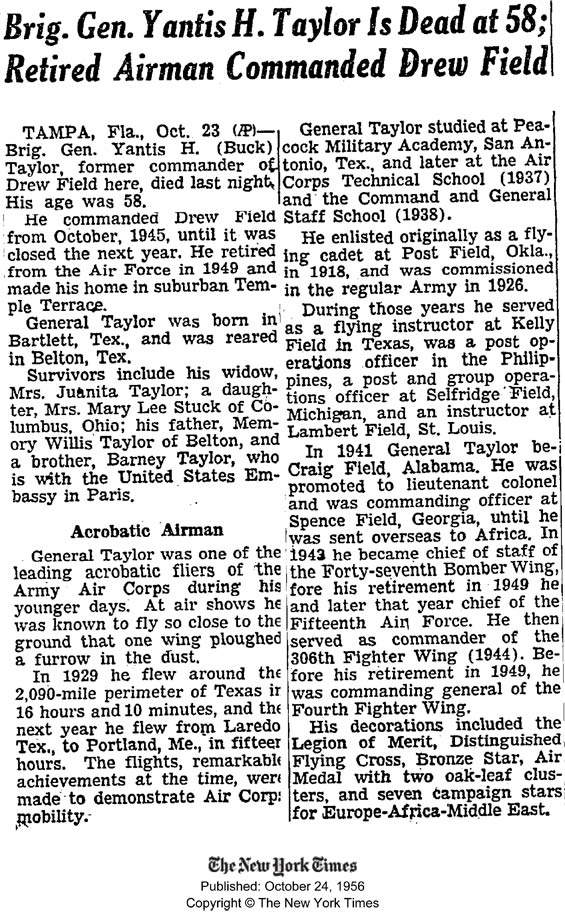 |
---o0o---
Dossier 2.2.169
THIS PAGE UPLOADED: 04/11/12 REVISED: 07/03/13, 11/24/14, 11/16/16
|









